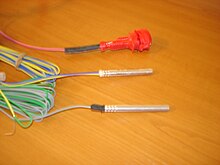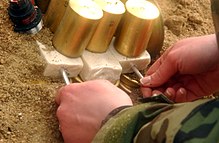
Back كبسولة التفجير Arabic Дэтанатар Byelorussian Детонатор Bulgarian Detonador Catalan Detonator Danish Sprengzünder German Πυροκροτητής Greek Prajmo Esperanto Detonador Spanish Detonaator Estonian
This article has multiple issues. Please help improve it or discuss these issues on the talk page. (Learn how and when to remove these template messages)
|


A detonator is a device used to make an explosive or explosive device explode.[1] Detonators come in a variety of types, depending on how they are initiated (chemically, mechanically, or electrically) and details of their inner working, which often involve several stages. Types of detonators include non-electric and electric. Non-electric detonators are typically stab or pyrotechnic while electric are typically "hot wire" (low voltage), exploding bridge wire (high voltage) or explosive foil (very high voltage).[2] [3]
The original electric detonators invented in 1875 independently by Julius Smith and Perry Gardiner used mercury fulminate as the primary explosive. Around the turn of the century performance was enhanced in the Smith-Gardiner blasting cap by the addition of 10-20% potassium chlorate.[4] This compound was superseded by others: lead azide, lead styphnate, some aluminium, or other materials such as DDNP (diazo dinitro phenol) to reduce the amount of lead emitted into the atmosphere by mining and quarrying operations. They also often use a small amount of TNT or tetryl in military detonators and PETN in commercial detonators.
- ^ "Definition of DETONATOR". www.merriam-webster.com. 2024-07-28. Retrieved 2024-08-10.
- ^ Oyler, Karl; Mehta, Neha; Cheng, Gartung (2015-11-01). "Overview of Explosive Initiators" (PDF). Defense Technical Information Center. Archived (PDF) from the original on 2022-04-02. Retrieved 2024-08-09.
- ^ Neal, William (2020-09-18). PETN Exploding Bridgewire (EBW) Detonators: A Review (Report). Los Alamos National Laboratory (LANL), Los Alamos, NM (United States).
- ^ Cooper, Paul (1996). Explosives Engineering. Wiley. pp. 337–339. ISBN 0-471-18636-8.
{{cite book}}: CS1 maint: date and year (link)
© MMXXIII Rich X Search. We shall prevail. All rights reserved. Rich X Search